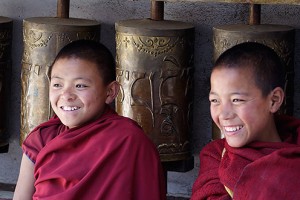An excerpt from a teaching called Intimacy with the Path by Jetsunma Ahkon Lhamo
When we think of the path, we think of something that is external, separate from us, something in front of us that we have to move towards or attain. A different understanding of the path might be that the path is something that actually engages with what you might call three faces. But these three faces are very much like us. You could say that each one of us has at least three faces. Each one of has the face of anger or discontentment, the face of joy, and the face of balance or contentment. There are many different faces that we have.
The path also has faces and when we truly study them we can understand what the nature of the path actually is. You could say that the path exists as part of a three-part system and if you were to think of the path itself in a true and more profound way than we normally think, you would understand that there is no way to tell where the path begins and where the path ends. We would understand that comprising what we call the path are three faces which are (1), the ground or basis from which the path arises, (2) the path or movement itself, the display of that source or fundamental nature from which the path arises, and (3) the fruit, which is the direct result of that fundamental nature as well as the direct result of the activity of that fundamental nature.
These three things, the ground, the path and the fruit or result cannot be separated in any way, shape, manner or form. The moment that we begin to separate these three aspects, we have lost touch with what the path actually is. We have lost touch with an intuitive understanding of how to practice the path, and we experience a great deal of delusion concerning the path when we separate ourselves from the understanding of the threefold face of the path: the basis or ground; the movement or path itself; and the result of the path.
Without this understanding, anything that we do becomes a path. Any activity that we engage in becomes a method. That method connects something with something or it wouldn’t be a method. But on the path of Buddha Dharma we have to remain connected with the ground, the method, and the result. These three have to be considered as threefold.
How is it that we can use this understanding to determine the validity of the path and to remove from ourselves the tendency toward delusion? First of all there is the teaching on the relationship of the seed and the fruit. There is that kind of good old-fashioned, common-sense wisdom that if you really want to have an apple tree in your orchard, you’ve got to plant an apple seed, that if you wanted an apple tree in your orchard and were to plant cabbages, it simply would not work. You would have cabbages, not apples. If you wished for some apples and you were to plant asparagus, that’s not going to turn out really well for you unless you really determine that asparagus is your thing. I know it sounds like I’m being silly and belaboring this point. The moment we get it, I’m going to stop nagging about it, because as yet we haven’t got this one and it’s really, really important.
The Buddha Dharma is not a path or a method that arises in any common or ordinary way in the world. In other words, someone didn’t get born at some time and simply compose a path. A team of experts or technicians didn’t get together and engineer a path. NASA didn’t design this one. This path was not a dream or a vision that someone had about twenty years ago that remains unproven or insubstantial.
The path of Buddha Dharma as we know it only arises when the condition of the Buddha nature appears. It arises from the mind of enlightenment – the Buddha nature. Lord Buddha did not begin to teach the path, although he had attained varying degrees of what you might call cosmic consciousness or something like that, before he actually attained supreme enlightenment. He had various degrees of consciousness that he could communicate and various qualities that he could teach to others—teachings on compassion, Bodhicitta, practicing meditation—but in fact he did not teach until he awakened into the primordial nature that was his true nature, Buddhahood. And then at that time he was able to display the path or method to the world.
The path or method actually came forth from his realization. It did not come forth even one millisecond before his realization. Once he achieved that precious awakening, he was able to bring the path to the world. During the course of Lord Buddha’s life he discovered that there were many different displays of consciousness, many different levels of attainment and attunement that one could accomplish and he did accomplish many of these before that ultimate moment. But it was that ultimate awakening that he presented to the world as the Buddha Dharma.
The seed of the method that we practice is enlightenment, the Buddha nature itself. It is not the human nature. If it were the human nature he would have taught before that precious awakening and that would have been something from the human capacity. But it was not until supreme realization that he began to teach the method and he taught only that method which leads to supreme enlightenment. So the seed and the method are completely married and not separable.
© copyright Jetsunma Ahkon Lhamo All rights reserved.

